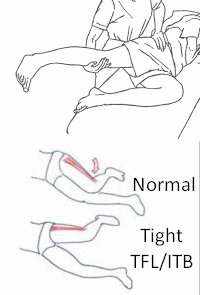Tensor fascial latae (TFL) originates from the anterior superior iliac spine (ASIS) outer surface, outer lip of anterior iliac crest and deep surface of fascia latae, continues down in thigh as Iliotibial band (ITB) and inserts to the ipsilateral Gerdy’s tubercle. TFL plays role in flexion, medial rotation and abduction of the hip joint and lateral stabilization of knee joint. At 0-30 degrees of knee flexion, ITB acts as a knee flexor (lies anterior to lateral femoral epicondyle) and from >30 degrees of knee flexion, ITB acts as a knee extensor (lies posterior to lateral femoral epicondyle).
Use: To test the tightness of TFL/ITB
Method:
Patient lies laterally on the normal hip with the affected hip upwards. The normal (lower) leg must be flexed at hip and knee (for stability and to flatten the lumbar curve). The examiner stands behind the patient and stabilizes the pelvis/greater trochanter with one hand. With the other hand, the affected leg is grasped and the knee is flexed to 90 degrees. The examiner then gradually lifts (abducts and extends the hip to center the ITB on greater trochanter) of affected leg with the knee flexed. Then, the examiner slowly allows the upper leg to lower (making sure the hip doesn’t fall into flexion and internal rotation) until the examiner is no longer supporting the weight of the upper leg.
Modified Ober’s test: This is same as the Ober’s test but the affected (upper) limb is extended at knee rather than flexed to reduce the influence of tight two-joints rectus femoris. Medial rotation is of more concern compared to the Ober’s test.
Original ober’s test selectively stresses TFL more than ITB and the modified test reverses this tendency (ITB>TFL).
Interpretation:
a. Tight TFL and ITB: Upper (affected) leg would remain in abducted position and doesn’t fall to the table or the pelvis tilts laterally and patient experiences lateral knee pain
b. Greater trochanteric bursitis: Pain over greater trochanter
c. Neurologic symptoms and pain in thigh: Tension in femoral nerve
d. Normal: The leg will slowly drop down towards the table and the patient doesn’t experience any pain
Ober’s test may be positive in poliomyelitis or meningomyelocele.
